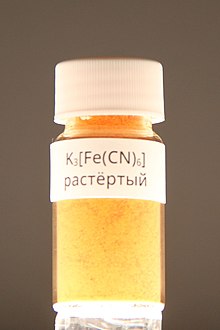
Back Kaliumheksasianoferraat(III) Afrikaans فريسيانيد البوتاسيوم Arabic پوتاسیوم فریسیانید AZB পটাসিয়াম ফেরিসায়ানাইড Bengali/Bangla Ferricianur de potassi Catalan Hexakyanidoželezitan draselný Czech Калий гексацианоферрачĕ(III) CV Kaliumhexacyanidoferrat(III) German Σιδηρικυανιούχο κάλιο Greek Kalia fericianido Esperanto

| |

| |
| Names | |
|---|---|
| IUPAC name
Potassium hexacyanoferrate(III)
| |
| Other names
Red prussiate of Potash,
Prussian red, Potassium ferricyanide | |
| Identifiers | |
3D model (JSmol)
|
|
| ChEBI | |
| ChemSpider | |
| ECHA InfoCard | 100.033.916 |
| EC Number |
|
| 21683 | |
PubChem CID
|
|
| RTECS number |
|
| UNII | |
CompTox Dashboard (EPA)
|
|
| |
| |
| Properties | |
| K3[Fe(CN)6] | |
| Molar mass | 329.24 g/mol |
| Appearance | deep red crystals, sometimes small pellets, orange to dark red powder |
| Density | 1.89 g/cm3, solid |
| Melting point | 300 °C (572 °F; 573 K) |
| Boiling point | decomposes |
| 330 g/L ("cold water") 464 g/L (20 °C) 775 g/L ("hot water")[1] | |
| Solubility | slightly soluble in alcohol soluble in acid soluble in water |
| +2290.0·10−6 cm3/mol | |
| Structure | |
| monoclinic | |
| octahedral at Fe | |
| Hazards | |
| GHS labelling: | |

| |
| Warning | |
| H302, H315, H319, H332, H335 | |
| P261, P264, P270, P271, P280, P301+P312, P302+P352, P304+P312, P304+P340, P305+P351+P338, P312, P321, P330, P332+P313, P337+P313, P362, P403+P233, P405, P501 | |
| NFPA 704 (fire diamond) | |
| Flash point | Non-flammable |
| Lethal dose or concentration (LD, LC): | |
LD50 (median dose)
|
2970 mg/kg (mouse, oral) |
| Safety data sheet (SDS) | MSDS |
| Related compounds | |
Other anions
|
Potassium ferrocyanide |
Other cations
|
Prussian blue |
Except where otherwise noted, data are given for materials in their standard state (at 25 °C [77 °F], 100 kPa).
| |

Potassium ferricyanide is the chemical compound with the formula K3[Fe(CN)6]. This bright red salt contains the octahedrally coordinated [Fe(CN)6]3− ion.[2] It is soluble in water and its solution shows some green-yellow fluorescence. It was discovered in 1822 by Leopold Gmelin.[3][4]
- ^ Kwong, H.-L. (2004). "Potassium Ferricyanide". In Paquette, L. (ed.). Encyclopedia of Reagents for Organic Synthesis. New York: J. Wiley & Sons. doi:10.1002/047084289X. hdl:10261/236866. ISBN 9780471936237.
- ^ Sharpe, A. G. (1976). The Chemistry of Cyano Complexes of the Transition Metals. London: Academic Press.
- ^ Gmelin, Leopold (1822). "Ueber ein besonderes Cyaneisenkalium, and über eine neue Reihe von blausauren Eisensalzen" [On a particular potassium iron cyanate, and on a new series of iron salts of cyanic acid]. Journal für Chemie und Physik (in German). 34: 325–346.
- ^ Ihde, A.J. (1984). The Development of Modern Chemistry (2nd ed.). New York: Dover Publications. p. 153.
© MMXXIII Rich X Search. We shall prevail. All rights reserved. Rich X Search
